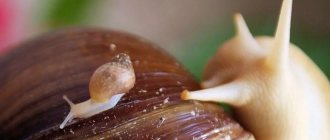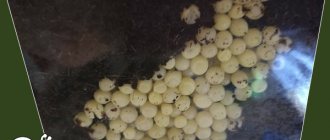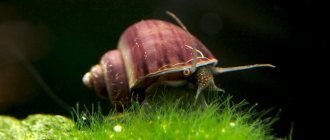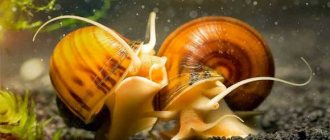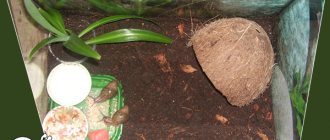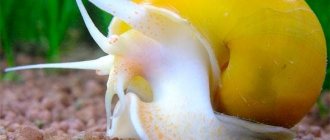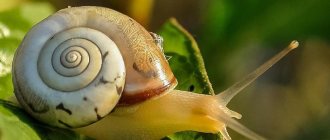Freshwater snails are an important part of the aquarium ecosystem; keeping them at home does not require much effort. The reproduction of most heterosexual and unisexual species of mollusks is unusually fast; in a short time, young individuals fill the aquarium space. Aquarists should know how snails reproduce in order to promptly remove excess young and prevent overpopulation.
Unisexual and heterosexual species of snails
The mollusks living in the aquarium are bisexual and hermaphrodite. In the first, a male and a female participate in reproduction; these are the following species:
- Ampoules;
- Tiger snails;
- Neretina;
- Maryse;
- Tylomelania;
- Predatory Helena;
- Pagodas.
Hermaphrodites are snails that can change sex depending on the characteristics of the population and reproduce without the participation of individuals of the opposite sex. These are the following types:
- Tropical pond snails;
- Fizy;
- Coils;
- Tuberous melonoides.
About snail breeding
If someone decides to become an Achatina breeder, he should familiarize himself with some of the features of breeding this type of mollusk. And also take into account the nuances that will inevitably be present during this process.
The first signs of snail pregnancy are the cessation of its growth. This is understandable: nature has arranged it so that all new cells of the mother’s body develop for the benefit of the offspring. That is, you should not count on your pet reaching gigantic sizes; the choice is made in favor of one thing. Either a large and beautiful mollusk, or breeding offspring.
A snail that is preparing to lay eggs, and after laying it loses its presentable appearance. Its shell becomes faded, flakes and cracks as a result of the loss of large amounts of calcium.
On average, an adult is capable of laying from 200 to 500 eggs at once (5 - 6 clutches per year). At the same time, young mollusks develop very quickly, and already in the first days of their life they become quite voracious.
It is sometimes impossible to distribute a large number of snails into good hands. Therefore, you should think carefully about this before breeding them.
The Achatina snail belongs to the order of hermaphrodites (each individual is capable of having both male and female sexual characteristics). But you shouldn’t worry in advance. Self-fertilization in these mollusks occurs in rare cases, based on which a pair should be purchased for them.
To get healthy offspring, you should choose large mollusks with richly colored shells without signs of disease. In this case, the individuals must be from different clutches. “Relatives” must not give birth to offspring. The selected two snails are placed in a common terrarium for some time.
You can tell whether Achatina is ripe for reproduction or not by the color of the tubercle present on the snail’s neck. When it becomes light, the mollusk is ready to reproduce. Usually, molluscs become sexually mature when they are six months old.
The question of how long it takes for snail eggs to hatch is very popular among novice Achatina breeders. In fact, after only 7 - 15 days the snail tries to find a place to lay eggs, and within a month it has offspring.
The optimal temperature for embryo development is from +15°C.
Creating conditions for snail breeding
Reproduction at home among mollusks occurs almost continuously. Without control of the situation, in a short period of time, young individuals literally flood the aquarium space.
How to create comfortable conditions for snail breeding in an aquarium:
- for 4 individuals, take a tank with a volume of 30 liters or more;
- control the water temperature within 25-28°C;
- hardness and acidity do not matter, leave these water parameters the same as usual;
- give food in sufficient quantities once a day or two;
- feed with regular food with the addition of boiled vegetables and bread;
- enrich the diet with calcium;
- change the water weekly without adding water to the edge of the aquarium;
- remove uneaten food from snails.
Eggs are laid on the leaves of underwater plants, tank walls, and decorative elements.
How to stimulate spawning
The snail breeding process must be approached responsibly. They need strict adherence to water temperature. It can range from 25° to 28°. Sudden changes in temperature should not be allowed.
You need to line the bottom of the aquarium with coconut bedding. Sometimes during gestation the snail's shell may burst. To prevent this from happening, a little calcium is added to her diet daily. If all conditions are met, mollusks reproduce every 3-5 days.
How do ampullaria reproduce?
Popular Amazonian snails with a yellow or brown-yellow shell reach a diameter of 10 cm. Ampularia is a heterosexual species.
It is impossible to determine the gender; the female does not differ from the male in appearance. Therefore, aquarists buy 4-6 individuals for breeding. You can understand which gender is which by seeing how ampullaria reproduce in an aquarium: the male is always on top during the mating process.
Sexual maturity occurs at 1.5 years. How do yellow snails reproduce in an aquarium:
- After fertilization, eggs are formed in the female's body.
- She deposits them above the water in the form of a slimy mass that hardens in the air.
- In nature, masonry rests on coastal stones and plants. In ampullaria, reproduction in an aquarium occurs on a glass aquarium wall.
- At first, the eggs are translucent, white, with a soft shell, and are 2 mm in diameter. They gradually darken - shells form inside. Just before the young hatch, the eggs are dark brown and hard.
- The developed snails gnaw through the shell of the eggs and come out.
It is necessary to monitor how the snails lay eggs in the aquarium: the clutch should not be allowed to get into the water or get wet, otherwise the embryos will die. How to care for ampularia eggs: drying out of the masonry is unacceptable; if it is laid near a lighting fixture, it will have to be carefully cut off and moved to another place inaccessible to fish and predatory snails. To make it easier to care for caviar, you can place it on a piece of foam plastic placed on the surface of the water.
How quickly snail eggs mature in an aquarium depends on the temperature of the surrounding water. At a temperature of 24-26°C, the ripening period is 2 weeks. At 20°C, young animals appear after 3 weeks.
Caring for young animals is simple: feed – duckweed, finely chopped lettuce leaves, dry planktonic crustaceans. When bred in a community aquarium, young specimens can be eaten by fish, so it is better to move them to a separate tank.
How pregnancy affects snail health
Most often, in the natural habitat, pregnancy in Achatina occurs without complications, but in home conditions, unforeseen difficulties are possible.
- Pregnancy inhibits the growth and development of mollusks
- The formation of egg clutch consumes calcium and protein reserves;
- The snail shell becomes thinner, exfoliates and becomes deformed;
- It hibernates if the snail is young and small in size.
Before you start breeding Achatina snails, you must clearly understand that several hundred snails hatch from one clutch, which require a large terrarium, proper care and nutrition. Read about keeping small Achatina. African snails grow quickly and are not so easy to sell or house, and the more snails, the higher the costs. Therefore, breeding snails in order to admire the babies is stupid and imprudent.
How do Achatina reproduce?
African Achatina are large land mollusks, with high-quality care and maintenance, reaching up to 30 cm in diameter, weighing up to 500 g. Sexual maturity occurs at one year of age. Egg laying occurs every 2 months.
Achatina is a unisexual species, although its representatives are not prone to self-fertilization. More often, individuals fertilize each other. Moreover, they do not have female and male reproductive organs; instead, calcareous formations come out of the front part of the body. The function of the female, that is, the carrier of eggs, is taken over by a larger individual whose body is stronger. Sperm in the Achatina body is stored in a viable state for up to 2 years.
How do snails reproduce in an aquarium?
- Pregnancy lasts 2 weeks.
- Then the pregnant female lays about 200 eggs for further 2-3 weeks of gestation.
- Eggs have a hard shell. As the embryos develop, it becomes thinner and releases minerals to the developing shell.
- When the shell becomes very thin, the snail breaks it and is released.
Feeding of young animals is the same as for adult mollusks. But the food needs to be crushed.
Mr. Tail recommends: the most common aquarium snails
There are many varieties of aquarium snails, including omnivores and predators, which are bred separately. They come from Southeast Asia, Thailand, and Africa. In nature, they live in ponds, lakes, streams, and rivers.
| View | Description |
| Reels | Freshwater mollusks do not require special care and live even in dirty water. They reproduce very quickly, lifespan is 1 year. The shell looks like a narrow, twisted spiral with 4-5 turns. Color – bright red, brown. Reach 3.5 cm in nature, 1 cm in an aquarium. They crawl on surfaces and in water and live for one year. They eat dead algae and destroy bacterial film. |
| Physidae | Hermaphrodites, measuring 17 mm, in an aquarium 8-9 mm, often bring them in accidentally, along with plants. Ovoid shell up to 3-5 whorls, pink, brown, yellow-brown color. They eat leftover food and green deposits on glass. But they are useful only in small quantities. They live up to 2 years. |
| Ampoules | Peaceful snails, kept with fish, eat a lot, grow up to 15 cm. Yellow, also blue, white, black, blue are more common. They live for 2 years. |
| Melania | Viviparous, dioecious, gray mollusks live in the soil in the aquarium, loosen it and improve water circulation, appearing only at night. The carapace is in the form of a cone, 3 cm long, has 6-7 whorls. Lifespan – 2 years. |
| Helena | Predators love soft ground. Yellow with dark or black stripes. Diverse, reproduce slowly. They feed on snails. Dimensions 2 cm. Lives 2-4 years. |
| Tylomelania | Viviparous, beautiful, yellow, orange, olive, black, distinguished by an unusual structure. The mouth part is similar to the proboscis of a tapir. The body is bright yellow. Demanding on content. Lifespan – 2-3 years. |
| Neretina | They are heterosexual, similar to the Colorado potato beetle, small, clean the aquarium, but their eggs there are often not viable, they live for 2-3 years. Adapts poorly to new conditions. |
| Maryse | Up to 5 cm in size, beautiful, golden, twisted shell with dark stripes. They breathe atmospheric air, can leave the aquarium and walk around the house, are dioecious, males can be easily distinguished from females, and are omnivorous. They live from 2 to 4 years. |
| Pagodas (brothia) | A rare species, reaching 6 cm. Sensitive to the oxygen content in water. Viviparous, dioecious. They live no more than 6 months. |
Snails from natural bodies of water should not be kept at home (pond snails, meadows, pearl barley). They eat vegetation at the roots and carry diseases and pests.
Photo gallery of snails:
Reproduction of other types of snails
Let's look at how other popular types of mollusks mate and how to breed them in an aquarium:
- Melanias are viviparous snails. They can reproduce by parthenogenesis, that is, without fertilization of the female by the male. Young individuals are born full-fledged. More than 10 cubs are born in one birth.
- Pagodas are livebearers and reproduce once a year. Childbirth occurs a month after mating.
- Maryses mate for almost 24 hours. Snail eggs in the aquarium appear every 4-5 days and mature within a week. In males, the fleshy leg is light with brown speckles, in females it is dark brown with black spots.
- The coils are multiplying rapidly. What does caviar look like: it is translucent, similar to bubble wrap, but hard. The young appear after 3-4 weeks.
- Physidae are characterized by rapid reproduction. About 20 laid eggs mature in a month.
- Neretina breed in warm salted water. Since there is no sexual dimorphism, 8-10 individuals are selected in preparation for reproduction.
- Predatory helenas lay 1-2 eggs. After spawning, they bury themselves in the ground and come to the surface only six months later.
- Tylomelania lay 2 eggs. Preparation for spawning includes installing a separate tank.
In most species, eggs take up to a month to develop. If after this period the young animals have not hatched, the clutch will have to be destroyed: it is dead.
Achatina snail eggs
After mating, both snails received the necessary cells for fertilization. Theoretically, two individuals can become mothers and create a clutch of Achatina. But in practice, the role of the female is taken over by a larger and stronger individual, which was able to accumulate vital energy for procreation.
Small, fragile mollusks are not simply given a period of gestation.
Two weeks after mating, the pet will have “eggs”. These are future snail eggs that are visible through the breathing hole under the shell.
For 12-14 days, the female bears eggs, and then burrows into the ground to create a clutch of Achatina and place future children in a secluded place. The white spot on the head, which serves as a mating hole, now serves as an oviparous organ. The eggs of Achatina snails are smooth and slippery; they easily move inside the female’s body and fly out into the ground.
The clutch of Achatina looks like a scattering of white translucent pearls. The beads are small, up to 5 mm in diameter, and shaped like oval chicken eggs. Beginner breeders ask how many eggs hatch from a female's body after her first pregnancy? According to the owners' observations, the mother first lays two dozen fatty eggs. They are empty and serve as food for future babies. And then, within a few hours, it can lay from 100 to 400 small pearl eggs.
Through the transparent walls of the container you can observe the snail eggs. All the “eggs” are different in size, some are very small, they are useless. And the largest and most beautiful ones will be able to turn into healthy and strong snails.
Caring for Achatina snail eggs - recommendations and useful tips
In a home container, it is necessary to create all the conditions for comfortable maintenance of the masonry. It is advisable to carefully transfer the eggs using a plastic spoon to another terrarium with soft moss or a plastic container with holes for air.
Egg care begins with screening!
The entire masonry along with the soil is poured onto a large plate to sort through. Breeders usually leave 10-12 healthy large testicles. The rest are frozen or processed to feed growing adults.
On a note! If the testicle is bluish in color, then the embryo will not develop in it. A viable testicle has a pure white or slightly yellowish tint!
What to do with extra snails
To remove excess shellfish from an aquarium, the following methods are used:
- Use chemicals from a pet store and add them to the aquarium water according to the instructions.
- Electric current is applied. This method of regulating the number of mollusks is only for experienced aquarists.
- Adults and eggs are caught by hand.
- They breed mollusks that do not reproduce in fresh water.
- They breed a predatory helena, which produces small offspring and devours other mollusks.
Reproduction of snails, which perform an important role as cleaners in a community aquarium, is not difficult. The aquarist only needs to control the number of individuals and prevent overpopulation.
Which snails should you not mate?
If you want to get healthy and viable snails, then do not mate snails from the same clutch, “parents” and “children,” “brothers” and “sisters.” Healthy and large mollusks from different families are allowed to reproduce. Mate snails of the same species and variety.
It should be noted that if you want to grow a large snail, then you should not rush into reproduction, since pregnancy completely inhibits the further development and growth of the mollusk. On the Internet you can find a recommendation that it is not advisable to mate a snail until it is one year old; Achatina is actively growing and developing.
See more similar articles:
Achatina Achatina: types of reproduction, nutrition and all about the tiger...
Caring for young animals
When the time comes, the snail eggs begin to crack, burst, the egg “cluster” disintegrates, and a couple of hundred tiny snails are born. The size is no more than 2 mm. However, these are already fully formed individuals that do not need any special care.
After birth, the babies immediately rush into the water. During such a journey, many hatched ampullaria die: they get stuck between stones, crawl into the filter, and become prey for other inhabitants of the water house. If the clutch was not initially located in a separate hatchery, then just before birth it is worth providing a hatching container, which should be placed directly under the egg clutch, filled with water. To do this, you can use a cut plastic bottle. Then the cubs will fall into it. They should be placed in a separate housing, which is easier to care for.
In order for babies to gain weight well, they need to eat well and satisfyingly. Any fish food is suitable for feeding young animals. It is first crushed into dust and scattered along the bottom. You should not lay soil in the nursery; it will be difficult for the little ones to pick up food from it. In addition to dry granules, boiled cabbage leaves, lettuce leaves, scalded cyclops, and finely chopped duckweed can be eaten. It will not be possible to overfeed baby ampullaria - they will not eat too much.
Attention! Despite the fact that the cubs appear at the same time, they grow at different rates. As the young animals develop, the older individuals are successively moved to a larger container.
The peculiarity of caring for young animals is isolation from predators and proper feeding
In the home of small snails, it is necessary to ensure cleanliness: aerate twice a day, remove uneaten food in a timely manner, perform water changes every three days by 30%, check the container for the presence of dead snails. They must be removed immediately so as not to poison the water with decay products. A week after birth, about half of the entire rootstock dies. Survival of the fittest.
It happens that the shells of growing mollusks crack and collapse. This means that the water in the vessel is too soft. To correct the situation, add one level tablespoon of ordinary table salt per 50 liters of liquid to the container. Soon the holes in the shell will close up.
Egg transfer
An important question is what to do with snail eggs and should they be transferred to another container?
Some breeders move the clutch to another place, away from large individuals that can accidentally damage them. The eggs are carefully taken out with a spoon, placed in another container, and sprinkled with 1 - 2 cm of good soil. A silicone or plastic spoon is used for this.
It is strictly prohibited to pick up eggs. The human body temperature is too high for the embryo. The shell may become cracked and the embryo will die.
How does masonry work?
Achatina snail eggs appear after the mollusk burrows into the ground, and the incubation period itself lasts 3 - 5 weeks.
The number of eggs in one clutch is often 100, although in some cases there can be several times more.
In the event that an African snail does not have the opportunity to lay eggs in soil suitable for it, it carries eggs for as long as possible until it finds the right soil. Therefore, there is a possibility of small snails appearing from eggs just a week after laying.
Achatina can also lay false eggs. They differ in color (translucent) and do not have a shell.
After fertilization occurs, Achatina can reproduce offspring for another two years, even if she is alone in the terrarium. The fact is that this mollusk is capable of storing sperm for a long time and using it for fertilization even in the absence of a partner.
